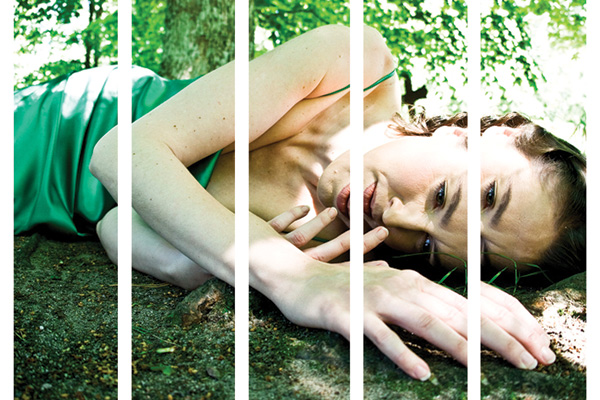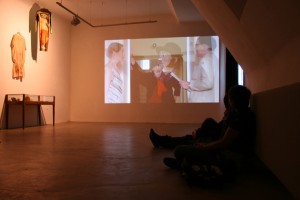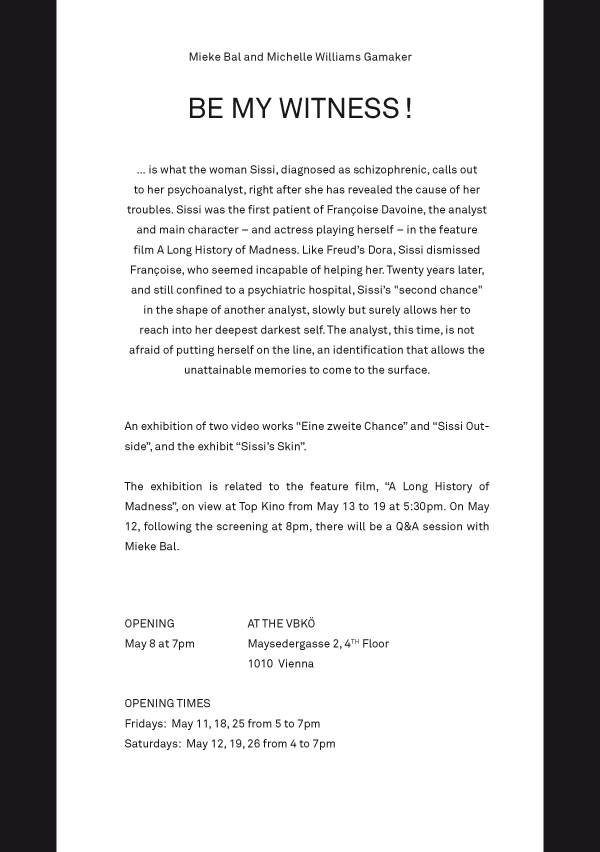Sei mein Zeuge!
… fordert Sissi, als schizophren diagnostiziert, ihre Psychoanalytikerin heraus, nachdem sie ihr die Ursache ihrer Probleme offenbart hat. Sissi ist die erste Patientin von Françoise Davoine, der Analytikerin, Hauptfigur und Schauspielerin, die sich im Film A Long History of Madness selbst spielt. So wie bei Dora und Freud, beendete Sissi die Therapie bei Françoise, die ihr nicht in der Lage erschien, ihr zu helfen. Zwanzig Jahre später und immer noch in einem psychiatrischen Krankenhaus eingeschlossen, erhält Sissi ihre “zweite Chance” durch eine andere Analytikerin, die ihr langsam aber sicher erlaubt, ihr innerstes, dunkelstes Selbst zu erreichen. Dieses Mal hat die Analytikerin keine Angst davor, sich in die Schusslinie zu begeben, und somit eine Identifikation zu ermöglichen, um unerreichbare Erinnerungen an die Oberfläche zu bringen.
In der westlichen Kultur besteht der „Wahnsinn“, in einer Vielzahl von medizinischen Begriffen als Psychose, Schizophrenie, Soziopathologie oder Ähnliches bezeichnet, als letzte Grenze, die Form der Alterität, die am schwersten zu bewältigen ist. Wahnsinn ist nicht auf Gruppen ethnischer, sexueller, Alters- oder rassischer Definition beschränkt. Vielleicht ist es deshalb so schwierig, die Grenze, die das „Verrückte“ von dem angeblich geistig Gesunden trennt, zu überwinden, weil wir den „Wahnsinn“ nicht definieren können, um ihn dann anderorts abzudrängen. Die „Verrückten“ werden somit der sozialen Ausgrenzung und Einsamkeit überlassen. Doch oftmals drückt sich das angeblich Verrückte in einem Überschuss aus: Da sie mehr Stimmen als die „Gesunden“ hören, haben „Verrückte“ ein reicheres Seelenleben.
Für Sissi nimmt dieser Überschuss die Form kaiserlichen Gehabes an: sie denkt, sie wäre – wie ihre Namenspatronin – die Kaiserin von Österreich-Ungarn. Sie wendet Zeit und Geld auf, sich entsprechend zu kleiden und zu frisieren, extravagante, wenn auch nicht kostbare Schmuckstücke zu tragen, und von oben herab mit ihrer Analytikerin zu sprechen. Die Therapeutin ist letzen Endes erfolgreich, da diese in der Lage ist zu sehen, wie Sissi sie “behandelt”, und dies andererseits auch Sissi sehen lässt. Dadurch erhält Sissi die Möglichkeit, sich ihrer dunklen Vergangenheit zuzuwenden.
Zwischen der Kunst und ihren Rezipient_innen ist ein Prozess ähnlicher Größenordnung möglich. Die Videoarbeit Eine zweite Chance führt den_die Zuschauer_in durch zwölf analytische Sitzungen, die die Psychoanalyse selbst umgestalten. Durch die sehr intensive Identifizierung mit der Patientin und die Vermittlung von Gleichwertigkeit wird letztere im Adressieren der psychischen Erkrankung effektiver.
In Eine zweite Chance wird diese Haltung auch dem_der Betrachter_in von Kunst angeboten, um auf die gleiche Weise lernen zu können, die Bereicherung zu erfahren, die Alterität mit sich bringen kann, diese zu akzeptieren und somit die Rolle des_r Zeugen_in zu billigen. In dem kürzeren Stummfilm, Sissi Outside, wird Sissi in ihrer Außenumgebung gezeigt, auf der historischen Insel Seili (Sjalö), wo eine Foucault-artige Leprakolonie in eine Nervenheilanstalt transformiert wurde, die die Umgebung für Sissis Aufenthalt bildet. Auch das Land und seine Geschichten sind somit Zeugen. Die Arbeit Sissi’s Skins besteht aus einigen Kleidern und Schmuckstücken, die Sissi in dem Video trägt. In gewisser Hinsicht lösen diese Objekte die strikte Grenze zwischen Fiktion und Dokumentation auf, da sie real und tragbar sind. Zum anderen sind sie Sissis engste Zeugen: Objekte, die bei ihr sind, wie eine zweite Haut. Die Würde, die diese auf sie übertragen, schützt sie gegen erneute Angriffe.
 Sissi Outside von Mieke Bal und Michelle Williams Gamaker
Sissi Outside von Mieke Bal und Michelle Williams Gamaker
Die Videoarbeiten von Mieke Bal und Michelle Williams Gamaker stehen im Zusammenhang mit dem Film A Long History of Madness, der vom 12. bis 19. Mai im Topkino zu sehen ist.
BE MY WITNESS! ist Teil von „NARRATION UND MIGRATION – Art-based Research / Research-based Art” , das vom 8. bis zum 26. Mai in Kooperation mit dem tfm | Institut für Theater-, Film- und Medienwissenschaft, der Brunnenpassage and dem Topkino stattfindet.
Mieke Bal (1946) ist eine Kulturtheoretikerin und Kritikerin, sie ist eine Professorin der Königlichen Niederländischen Akademie der Künste und Wissenschafen (KNAW). Ihre Forschungsschwerpunkte reichen von biblischer und klassischer Antike bis zur Geschichte des 17. Jahrhunderts sowie zeitgenössische Kunst und Literatur, Narratologie, Feminismus und Migrationskultur. Zu ihren zahlreichen Veröffentlichungen zählen A Mieke Bal Reader (2006), Travelling Concepts in the Humanities (2002) und Narratology (2009, 3. Aufl.). Mieke Bal tritt außerdem als Kuratorin und Videokünstlerin in Erscheinung, ihre experimentellen Dokumentarfilme über Migration umfassen die Videoarbeiten A Thousand and One Day und Colony sowie die Installation Nothing is Missing.
Michelle Williams Gamaker (1979) ist Künstlerin und Autorin. Ihre Arbeit reicht von einfachen Porträts und Installationen bis zu komplexen Darstellungen der Realität durch Dokumentar- und Spielfilme. Das subtile und außergewöhnliche Erzählpotential des Alltäglichen ist die Wurzel ihres Schaffens. Ihre Videoarbeit fand erstmals 2001 bei den “Bloomberg New Contemporaries” Anerkennung. Seitdem zeigt sie ihr Werk international. Ihre Dokumentarfilme umfassen Elizabitch (2004), All about Évike (2005), Colony (2006) und Becoming Vera (2007). Derzeit lebt und arbeitet Michelle Williams Gamaker in Amsterdam und London, wo sie ihren Phd in Bildender Kunst am Goldsmiths College abschloss und im MFA Art Practice Programm Teilzeit unterrichtet.




… is what the woman Sissi, diagnosed as schizophrenic, calls out to her psychoanalyst, right after she has revealed the cause of her troubles. Sissi was the first patient of Françoise Davoine, the analyst and main character – and actress playing herself – in the feature film A Long History of Madness. Like Freud’s Dora, Sissi dismissed Françoise, who seemed incapable of helping her. Twenty years later, and still confined to a psychiatric hospital, Sissi’s “second chance” in the shape of another analyst, slowly but surely allows her to reach into her deepest darkest self. The analyst, this time, is not afraid of putting herself on the line, an identification that allows the unattainable memories to come to the surface.
In Western culture, “madness”, or what is called by a variety of medicalising labels, psychosis, schizophrenia, sociopathology and the likes, remains the last frontier, the form of otherness that is hardest to deal with. Madness is not confined to groups of ethnic, sexual, age- or racial definition. Perhaps it is because we cannot define and then relegate it to elsewhere, it is so difficult to overcome the boundary that separates the mad from the allegedly sane, thus leaving them to social ostracism and loneliness. Yet, frequently, the alleged madness expresses itself in a surplus: hearing more voices than the sane, the mad have a richer psychic life.
For Sissi, this surplus takes the form of her imperial demeanour: she thinks she is (like) her namesake, the empress of Austria-Hungary. She spends time and money to dress and coif accordingly, wear extravagant albeit non-precious jewellery, and talks from high-up to her analyst. And it is because the latter is able to see how, in fact, Sissi “treats” her as much as the other way around that Sissi is enabled to reach into her darkest past.
Between art and its viewers, something of the same order is possible. The video piece Eine zweite Chance takes the viewer trough twelve analytical sessions that reshape psychoanalysis itself, making the theory effective in addressing madness thanks to an extreme identification and equality. It also offers such attitude for consideration to the viewer of art, enabled, equally, to learn to accept the enrichment otherness can bring, and thus endorse the role of witness. In a shorter, silent video, Sissi Outside, Sissi is shown in her environment outside, on the historic island of Seili (Sjalö) where a Foucault-type leprosy colony transformed into an asylum for the insane, forms the backdrop of confinement. The land and its histories are also witnesses. The exhibit Sissi’s Skins consists of a few of the dresses and jewellery Sissi wears in the video. In one sense, these objects erase the strict boundary between fiction and documentary. For, they are real, and wearable. In another sense, these are her closest witnesses; objects that were with her, like a second skin; and through the dignity they confer upon her, they protect her against renewed assault.
 Sissi Outside by Mieke Bal and Michelle Williams Gamaker
Sissi Outside by Mieke Bal and Michelle Williams Gamaker
The video works by Mieke Bal abd Michelle Williams Gamaker are related to the feature film, A Long History of Madness, on view at Topkino from May 12 to 19.
BE MY WITNESS! is part of „NARRATION UND MIGRATION – Art-based Research / Research-based Art”, that takes place in Vienna from May 8 to 26 in cooperation with tfm | Institut für Theater-, Film- und Medienwissenschaft, Brunnenpassage and Topkino.
Mieke Bal (1946), a cultural theorist and critic, is Royal Netherlands Academy of Arts and Sciences Professor (KNAW). She is based at the Amsterdam School for Cultural Analysis (ASCA), University of Amsterdam. Her areas of interest range from biblical and classical antiquity to 17th century and contemporary art and modern literature, feminism and migratory culture. Her thirty books include A Mieke Bal Reader (2006), Travelling Concepts in the Humanities (2002) and Narratology (3d edition 2009). Mieke Bal is also a video-artist, her experimental documentaries on migration include A Thousand and One Days; Colony and the installation Nothing is Missing. Her work is exhibited internationally. Occasionally she acts as an independent curator.
Michelle Williams Gamaker (1979) is a video artist and writer. Her work varies from single frame portraits and installations to complex renderings of reality via documentary and fiction. The subtle and sublime potential of storytelling through the everyday is at the root of her work. Her video work was first recognised in 2001 at the Bloomberg New Contemporaries. Since then she has exhibited internationally; her documentaries include Elizabitch (2004), All About Évike (2005), Colony (2006) and Becoming Vera (2007).
Michelle Williams Gamaker is currently based in Amsterdam and London where she finished her PhD in Visual Arts at Goldsmiths College, she also teaches part-time on the MFA Art Practice at Goldsmiths.

